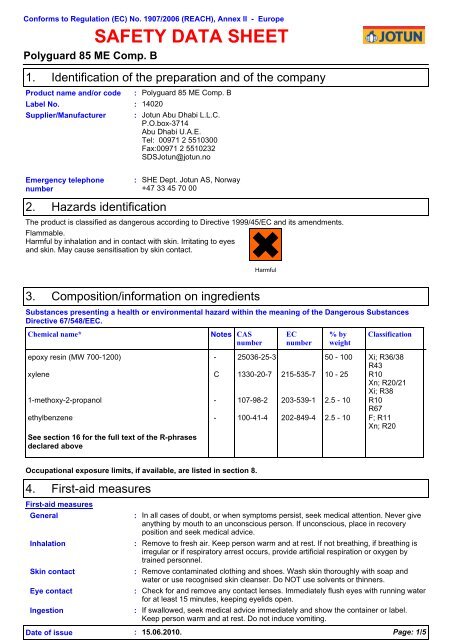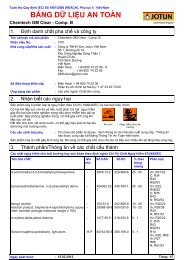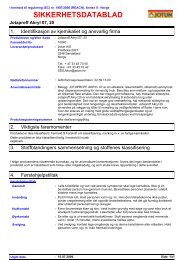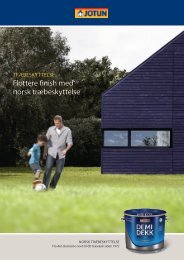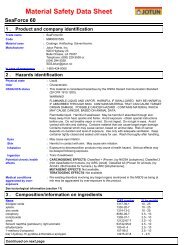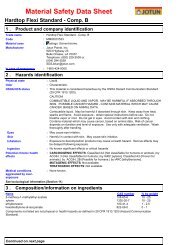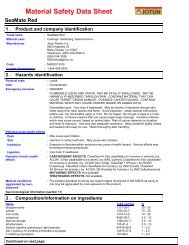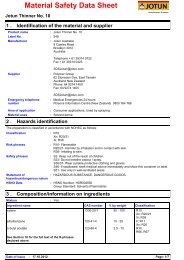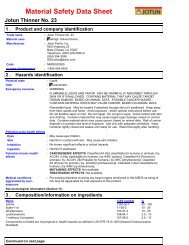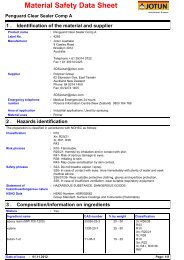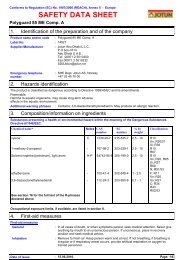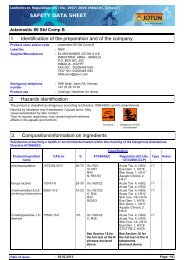Polyguard 85 ME Comp. B - Jotun
Polyguard 85 ME Comp. B - Jotun
Polyguard 85 ME Comp. B - Jotun
You also want an ePaper? Increase the reach of your titles
YUMPU automatically turns print PDFs into web optimized ePapers that Google loves.
Conforms to Regulation (EC) No. 1907/2006 (REACH), Annex II - Europe<br />
SAFETY DATA SHEET<br />
<strong>Polyguard</strong> <strong>85</strong> <strong>ME</strong> <strong>Comp</strong>. B<br />
1.<br />
Identification of the preparation and of the company<br />
Product name and/or code :<br />
<strong>Polyguard</strong> <strong>85</strong> <strong>ME</strong> <strong>Comp</strong>. B<br />
Label No. : 14020<br />
Supplier/Manufacturer : <strong>Jotun</strong> Abu Dhabi L.L.C.<br />
P.O.box-3714<br />
Abu Dhabi U.A.E.<br />
Tel: 00971 2 5510300<br />
Fax:00971 2 5510232<br />
SDS<strong>Jotun</strong>@jotun.no<br />
Emergency telephone<br />
number<br />
:<br />
SHE Dept. <strong>Jotun</strong> AS, Norway<br />
+47 33 45 70 00<br />
2.<br />
Hazards identification<br />
The product is classified as dangerous according to Directive 1999/45/EC and its amendments.<br />
Flammable.<br />
Harmful by inhalation and in contact with skin. Irritating to eyes<br />
and skin. May cause sensitisation by skin contact.<br />
Harmful<br />
3.<br />
<strong>Comp</strong>osition/information on ingredients<br />
Substances presenting a health or environmental hazard within the meaning of the Dangerous Substances<br />
Directive 67/548/EEC.<br />
Chemical name*<br />
Notes<br />
CAS<br />
number<br />
EC<br />
number<br />
% by<br />
weight<br />
Classification<br />
epoxy resin (MW 700-1200) - 25036-25-3 50 - 100 Xi; R36/38<br />
R43<br />
xylene C 1330-20-7 215-535-7 10 - 25 R10<br />
Xn; R20/21<br />
Xi; R38<br />
1-methoxy-2-propanol - 107-98-2 203-539-1 2.5 - 10 R10<br />
R67<br />
ethylbenzene - 100-41-4 202-849-4 2.5 - 10 F; R11<br />
Xn; R20<br />
See section 16 for the full text of the R-phrases<br />
declared above<br />
Occupational exposure limits, if available, are listed in section 8.<br />
4.<br />
First-aid measures<br />
First-aid measures<br />
General<br />
Inhalation<br />
Skin contact<br />
Eye contact<br />
Ingestion<br />
:<br />
:<br />
:<br />
:<br />
:<br />
In all cases of doubt, or when symptoms persist, seek medical attention. Never give<br />
anything by mouth to an unconscious person. If unconscious, place in recovery<br />
position and seek medical advice.<br />
Remove to fresh air. Keep person warm and at rest. If not breathing, if breathing is<br />
irregular or if respiratory arrest occurs, provide artificial respiration or oxygen by<br />
trained personnel.<br />
Remove contaminated clothing and shoes. Wash skin thoroughly with soap and<br />
water or use recognised skin cleanser. Do NOT use solvents or thinners.<br />
Check for and remove any contact lenses. Immediately flush eyes with running water<br />
for at least 15 minutes, keeping eyelids open.<br />
If swallowed, seek medical advice immediately and show the container or label.<br />
Keep person warm and at rest. Do not induce vomiting.<br />
Date of issue : 15.06.2010.<br />
Page: 1/5
<strong>Polyguard</strong> <strong>85</strong> <strong>ME</strong> <strong>Comp</strong>. B<br />
5.<br />
Fire-fighting measures<br />
Extinguishing media :<br />
Extinguishing media not to<br />
be used<br />
Recommendations<br />
Personal precautions<br />
Recommended: alcohol-resistant foam, CO 2, powders, water spray.<br />
: Do not use water jet.<br />
6. Accidental release measures<br />
: Fire will produce dense black smoke. Exposure to decomposition products may<br />
cause a health hazard. Appropriate breathing apparatus may be required.<br />
Cool closed containers exposed to fire with water. Do not release runoff from fire to<br />
drains or watercourses.<br />
:<br />
Exclude sources of ignition and ventilate the area. Avoid breathing vapour or mist.<br />
Refer to protective measures listed in sections 7 and 8. Contain and collect spillage<br />
with non-combustible, absorbent material e.g. sand, earth, vermiculite or<br />
diatomaceous earth and place in container for disposal according to local regulations<br />
(see section 13).<br />
Spill<br />
: Preferably clean with a detergent. Avoid using solvents.<br />
Note: see section 8 for personal protective equipment and section 13 for waste disposal.<br />
7.<br />
Handling and storage<br />
Handling<br />
Storage<br />
:<br />
:<br />
Vapours are heavier than air and may spread along floors. Vapours may form<br />
explosive mixtures with air. Prevent the creation of flammable or explosive<br />
concentrations of vapours in air and avoid vapour concentrations higher than the<br />
occupational exposure limits.<br />
In addition, the product should only be used in areas from which all naked lights and<br />
other sources of ignition have been excluded. Electrical equipment should be<br />
protected to the appropriate standard.<br />
To dissipate static electricity during transfer, earth drum and connect to receiving<br />
container with bonding strap. Operators should wear antistatic footwear and clothing<br />
and floors should be of the conducting type.<br />
Keep container tightly closed. Keep away from heat, sparks and flame. No sparking<br />
tools should be used.<br />
Avoid contact with skin and eyes. Avoid the inhalation of dust, particulates, spray or<br />
mist arising from the application of this preparation. Avoid inhalation of dust from<br />
sanding.<br />
Eating, drinking and smoking should be prohibited in areas where this material is<br />
handled, stored and processed.<br />
Put on appropriate personal protective equipment (see section 8).<br />
Never use pressure to empty. Container is not a pressure vessel.<br />
Always keep in containers made from the same material as the original one.<br />
<strong>Comp</strong>ly with the health and safety at work laws.<br />
When operators, whether spraying or not, have to work inside the spray booth,<br />
ventilation is unlikely to be sufficient to control particulates and solvent vapour in all<br />
cases. In such circumstances they should wear a compressed air-fed respirator<br />
during the spraying process and until such time as the particulates and solvent<br />
vapour concentration has fallen below the exposure limits.<br />
Store in accordance with local regulations. Observe label precautions. Store in a dry,<br />
cool and well-ventilated area. Keep away from heat and direct sunlight.<br />
Keep away from sources of ignition. Keep away from: oxidising agents, strong<br />
alkalis, strong acids.<br />
No smoking. Prevent unauthorised access. Containers that have been opened must<br />
be carefully resealed and kept upright to prevent leakage. Do not empty into drains.<br />
8. Exposure controls/personal protection<br />
Engineering measures<br />
:<br />
Provide adequate ventilation. Where reasonably practicable, this should be achieved<br />
by the use of local exhaust ventilation and good general extraction. If these are not<br />
sufficient to maintain concentrations of particulates and solvent vapours below the<br />
OEL, suitable respiratory protection must be worn.<br />
Date of issue : 15.06.2010.<br />
Page: 2/5
<strong>Polyguard</strong> <strong>85</strong> <strong>ME</strong> <strong>Comp</strong>. B<br />
Ingredient name<br />
xylene<br />
1-methoxy-2-propanol<br />
ethylbenzene<br />
Occupational exposure limits<br />
EU OEL (Europe, 12/2009). Absorbed through skin. Notes: list<br />
of indicative occupational exposure limit values<br />
STEL: 442 mg/m³ 15 minute(s).<br />
STEL: 100 ppm 15 minute(s).<br />
TWA: 221 mg/m³ 8 hour(s).<br />
TWA: 50 ppm 8 hour(s).<br />
EU OEL (Europe, 12/2009). Absorbed through skin. Notes: list<br />
of indicative occupational exposure limit values<br />
STEL: 568 mg/m³ 15 minute(s).<br />
STEL: 150 ppm 15 minute(s).<br />
TWA: 375 mg/m³ 8 hour(s).<br />
TWA: 100 ppm 8 hour(s).<br />
EU OEL (Europe, 4/2006). Absorbed through skin. Notes:<br />
Indicative<br />
Limit value: 100 ppm 8 hour(s).<br />
Limit value: 442 mg/m³ 8 hour(s).<br />
Short term limit value: 200 ppm 15 minute(s).<br />
Short term limit value: 884 mg/m³ 15 minute(s).<br />
Personal protective equipment<br />
Respiratory system :<br />
Skin and body<br />
:<br />
Hands<br />
:<br />
If workers are exposed to concentrations above the exposure limit, they must use<br />
appropriate, certified respirators. Use respiratory mask with charcoal and dust filter<br />
when spraying this product.(as filter combination A2-P2). In confined spaces, use<br />
compressed-air or fresh-air respiratory equipment. When use of roller or brush,<br />
consider use of charcoalfilter.<br />
Personnel should wear antistatic clothing made of natural fibres or of hightemperature-resistant<br />
synthetic fibres.<br />
Wear suitable gloves.<br />
Eyes<br />
9.<br />
Solubility<br />
:<br />
Not recommended, gloves(breakthrough time) < 1 hour: neoprene, butyl rubber<br />
May be used, gloves(breakthrough time) 4 - 8 hours: PVC<br />
Recommended, gloves(breakthrough time) > 8 hours: nitrile rubber, Teflon, 4H<br />
For right choice of glove materials, with focus on chemical resistance and time of<br />
penetration, seek advice by the supplier of chemical resistant gloves.<br />
The user must check that the final choice of type of glove selected for handling this<br />
product is the most appropriate and takes into account the particular conditions of<br />
use, as included in the user's risk assessment.<br />
Physical and chemical properties<br />
Physical state<br />
: Liquid.<br />
Odour<br />
: Characteristic.<br />
Colour<br />
: Clear.<br />
Flash point<br />
: Closed cup: 26°C (78,8°F)<br />
Density : 1.07 g/cm 3<br />
Explosion limits : 1.1 - 13.7%<br />
10.<br />
Stability and reactivity<br />
:<br />
Use safety eyewear designed to protect against splash of liquids.<br />
Insoluble in the following materials: cold water and hot water.<br />
Stable under recommended storage and handling conditions (see section 7).<br />
Hazardous decomposition products: carbon monoxide, carbon dioxide, smoke, oxides of nitrogen.<br />
Keep away from the following materials to prevent strong exothermic reactions: oxidising agents, strong alkalis, strong<br />
acids.<br />
Date of issue : 15.06.2010.<br />
Page: 3/5
<strong>Polyguard</strong> <strong>85</strong> <strong>ME</strong> <strong>Comp</strong>. B<br />
11.<br />
Toxicological information<br />
There is no data available on the preparation itself. The preparation has been assessed following the conventional<br />
method of the Dangerous Preparations Directive 1999/45/EC and classified for toxicological hazards accordingly. See<br />
sections 2 and 15 for details.<br />
Exposure to component solvent vapour concentrations in excess of the stated occupational exposure limit may result in<br />
adverse health effects such as mucous membrane and respiratory system irritation and adverse effects on the kidneys,<br />
liver and central nervous system. Solvents may cause some of the above effects by absorption through the skin.<br />
Symptoms and signs include headache, dizziness, fatigue, muscular weakness, drowsiness and, in extreme cases, loss<br />
of consciousness. Repeated or prolonged contact with the preparation may cause removal of natural fat from the skin,<br />
resulting in non-allergic contact dermatitis and absorption through the skin. If splashed in the eyes, the liquid may cause<br />
irritation and reversible damage. Swallowing may cause nausea, diarrhoea, vomiting, gastro-intestinal irritation and<br />
chemical pneumonia.<br />
Contains: epoxy resin (MW 700-1200). May produce an allergic reaction.<br />
12.<br />
Ecological information<br />
There is no data available on the preparation itself.<br />
Do not allow to enter drains or watercourses.<br />
The preparation has been assessed following the conventional method of the Dangerous Preparations Directive<br />
1999/45/EC and is not classified as dangerous for the environment.<br />
Aquatic ecotoxicity<br />
Product/ingredient name Test Result<br />
Species Exposure<br />
xylene Mortality Acute LC50 12000 to Fish - Bluegill 96 hours<br />
16114 ug/L Fresh water - Lepomis<br />
macrochirus -<br />
1,1 g<br />
ethylbenzene Population Acute EC50 7,2 mg/L Algae 48 hours<br />
Intoxication Acute EC50 2,93 mg/L Daphnia 48 hours<br />
Mortality Acute LC50 4,2 mg/L Fish 96 hours<br />
Ecological information<br />
Biodegradability<br />
Product/ingredient name Aquatic half-life Photolysis Biodegradability<br />
xylene - - Readily<br />
Bioaccumulative potential<br />
Product/ingredient name<br />
LogKow BCF Potential<br />
xylene 3,12 - high<br />
13.<br />
Disposal considerations<br />
Do not allow to enter drains or watercourses. Material and/or container must be disposed of as hazardous waste.<br />
European waste catalogue<br />
(EWC)<br />
14.<br />
Transport information<br />
International transport regulations<br />
Proper shipping name<br />
UN Number<br />
:<br />
:<br />
Paint.<br />
1263<br />
Class : 3<br />
Packing group<br />
: III<br />
Label<br />
:<br />
:<br />
08 01 11* waste paint and varnish containing organic solvents or other dangerous<br />
substances. If this product is mixed with other wastes, this code may no longer apply.<br />
If mixed with other wastes, the appropriate code should be assigned. For further<br />
information, contact your local waste authority.<br />
Transport within user’s premises: always transport in closed containers that are upright and secure. Ensure that<br />
persons transporting the product know what to do in the event of an accident or spillage.<br />
Date of issue : 15.06.2010.<br />
Page: 4/5
<strong>Polyguard</strong> <strong>85</strong> <strong>ME</strong> <strong>Comp</strong>. B<br />
Additional information<br />
ADR / RID<br />
IMDG<br />
: Tunnel restriction code: (D/E)<br />
Hazard identification number: 30<br />
Special provisions: 640E<br />
ADR/RID: Viscous substance. Not restricted, ref. chapter 2.2.3.1.5 (applicable to<br />
receptacles < 450 litre capacity).<br />
: Emergency schedules (EmS): F-E, S-E<br />
Marine pollutant: No.<br />
IMDG: Viscous substance. Transport in accordance with paragraph 2.3.2.5<br />
(applicable to receptacles < 30 litre capacity).<br />
Transport in accordance with ADR/RID, IMDG/IMO and ICAO/IATA and national regulation.<br />
15.<br />
Regulatory information<br />
EU regulations<br />
Hazard symbol or symbols<br />
: The product is classified and labelled for supply in accordance with the Directive<br />
1999/45/EC as follows:<br />
:<br />
Harmful<br />
Risk phrases<br />
Safety phrases<br />
Contains:<br />
Industrial use<br />
:<br />
:<br />
R10- Flammable.<br />
R20/21- Harmful by inhalation and in contact with skin.<br />
R36/38- Irritating to eyes and skin.<br />
R43- May cause sensitisation by skin contact.<br />
S23- Do not breathe vapour / spray.<br />
S36/37- Wear suitable protective clothing and gloves.<br />
S51- Use only in well-ventilated areas.<br />
: epoxy resin (MW 700-1200)<br />
xylene<br />
: The information contained in this safety data sheet does not constitute the user’s<br />
own assessment of workplace risks, as required by other health and safety<br />
legislation. The provisions of the national health and safety at work regulations apply<br />
to the use of this product at work.<br />
16.<br />
Other information<br />
CEPE Classification : 1<br />
Full text of R-phrases<br />
referred to in sections 2 and<br />
3 - Europe<br />
Date of issue : 15.06.2010.<br />
Version<br />
: 1.03<br />
Notice to reader<br />
:<br />
R11- Highly flammable.<br />
R10- Flammable.<br />
R20- Harmful by inhalation.<br />
R20/21- Harmful by inhalation and in contact with skin.<br />
R38- Irritating to skin.<br />
R36/38- Irritating to eyes and skin.<br />
R43- May cause sensitisation by skin contact.<br />
R67- Vapours may cause drowsiness and dizziness.<br />
This Safety Data Sheet is prepared in accordance with Annex II to Regulation (EC) No 1907/2006.<br />
Indicates information that has changed from previously issued version.<br />
The information in this SDS is based on the present state of our knowledge and on current laws. The product<br />
is not to be used for purposes other than those specified under section 1 without first obtaining written<br />
handling instructions. It is always the responsibility of the user to take all necessary steps to fulfil the<br />
demands set out in the local rules and legislation. The information in this SDS is meant to be a description of<br />
the safety requirements for our product. It is not to be considered a guarantee of the product's properties.<br />
Date of issue : 15.06.2010.<br />
Page: 5/5


